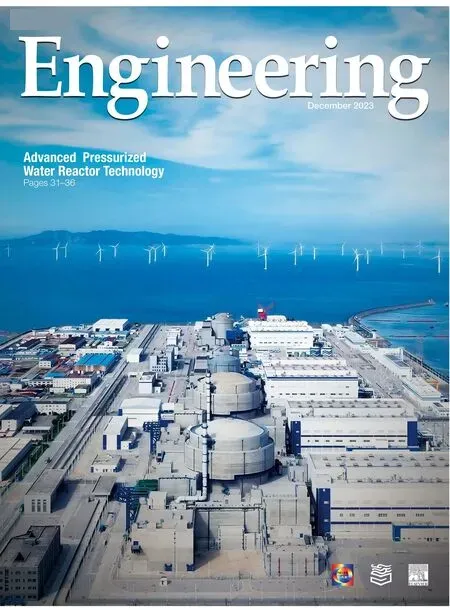Corrigendum to ‘‘Emerging Organic Contaminants in Chinese Surface Water: Identification of Priority Pollutants” [Engineering 11 (2022)111-125]
Mengmeng Zhong, Tielong Wng, Wenxing Zho, Jun Hung, Bin Wng, Lee Blney,b, Qingwei Bu,Gng Yu,*
a Beijing Key Laboratory for Emerging Organic Contaminants Control,State Key Joint Laboratory of Environment Simulation and Pollution Control(SKLESPC),School of Environment,Tsinghua University, Beijing 100084, China
b Department of Chemical, Biochemical, and Environmental Engineering, University of Maryland Baltimore County, Baltimore, MD 21250, USA
c School of Chemical and Environmental Engineering, China University of Mining and Technology-Beijing, Beijing 100083, China
The authors regret that the acceptable daily intake(ADI)values of 0.082 μg·kg-1·d-1for N,N-diethyl-3-methyl benzoyl amide(DEET), 0.19 μg·kg-1·d-1for triclosan, and 0.83 μg·kg-1·d-1for acetaminophen cited from a review by Murray et al.[1],as shown in Table S4 in Appendix A of the original article, were not correct.Blanset et al.[2] provided the original values of 100, 50, and 153 μg·kg-1·d-1for DEET, triclosan, and acetaminophen, respectively.In the present study, priority index was used as a multicriteria screening approach that is limited affected by individual criteria.As a result, triclosan was still included in the top-priority group I, but the priority of DEET changed from group II to group III, and acetaminophen remained in group III.The number of substances in priority II and III becomes 36 and 59, respectively.The ADI data,predicted no effect concentrations for humans(PNEChum),hazard potential, human health risk quotient (RQhum), priority index values,and priority groups of these chemicals have been corrected in Tables 1-3, 5, Tables S4-S6, S8-S10, S12, and S16 in Appendix A.
In addition, during manuscript preparation, errors occurred when copying several PNEChumvalues from Table S5 to Table S8.The PNEChumdata listed in Table S8 were incorrect,which affected the RQhumresults, but the prioritization result was not affected.The PNEChumand RQhumdata were corrected in Tables 1 and 2,and Table S8.The ranking list according to individual RQhumvalues in Table S13 in Appendix A and the top 50 emerging organic contaminants(EOCs)determined by RQhumvalues in Table 3 were also corrected.
The corrected Tables 1-3,5,Tables S4-S6,S8-10,S12,S13,and S16 are provided in the supplemental data to this corrigendum.
The text was corrected as follows.
(1)In the Abstract,‘‘37 chemicals were defined as high priority”,where ‘‘37” should be ‘‘36”; and ‘‘Overall, 20 pollutants were recommended as priority EOCs” where ‘‘20” should be ‘‘19”.
(2) In Section 3.3 Risk assessment, ‘‘In total, six EOCs exhibited a potential risk to human health with RQhumvalues greater than 0.1.Of these compounds, 17α-ethinylestradiol and perfluorooctanoate (PFOA) exhibited the highest human health risk with RQhumvalues of 43.41 and 1.92, respectively.Human health effects were also identified for estriol, 17α-estradiol, disulfoton,and estrone with RQhumvalues of 0.8, 0.2, 0.1, and 0.1, respectively.Four EOCs, namely 17α-ethinylestradiol, disulfoton, estriol,and estrone, posed risks to both human health and ecological systems.” should be corrected to ‘‘In total, five EOCs exhibited a potential risk to human health with RQhumvalues greater than 0.1.Of these compounds, 17α-ethinylestradiol exhibited the highest human health risk, with an RQhumvalue of 43.4.Human health effects were also identified for estriol, perfluorooctanoate(PFOA), 17α-estradiol, and estrone, with RQhumvalues of 0.8,0.7, 0.2, and 0.1, respectively.Three EOCs, namely 17α-ethinylestradiol, estriol, and estrone, posed risks to both human health and ecological systems.”
(3) In Section 3.4 Priority index,‘‘Group II (37 compounds with high priority); Group III (58 compounds with moderate priority)”,where ‘‘37” should be ‘‘36” and ‘‘58” should be ‘‘59”; and ‘‘The 37 compounds included in the high-priority group II are detailed in Table 2” where ‘‘37” should be ‘‘36”.
(4) In Section 3.8 Priority control recommendation, ‘‘Routine monitoring, derivation of environmental quality standards, and development of control strategies are recommended for the 20 priority control EOCs listed in priority group I/uncertain Category 1 and priority group II/uncertain Category 1” where ‘‘20” should be‘‘19”; and ‘‘If feasible, special attention should be also paid to the 27 EOCs in priority Group III/uncertain Category 1 and priority Group IV/uncertain Category 1” where ‘‘27” should be ‘‘28”.
(5) In the Conclusions, ‘‘RQ analysis identified six EOCs with human health effects and 94 EOCs with ecotoxicity concerns.Four EOCs,namely 17α-ethinylestradiol,disulfoton,estriol,and estrone,posed risks to both human and ecological health.A list of 11 top-priority compounds and 37 high-priority compounds was generated from the priority index.” should be corrected to‘‘RQ analysis identified five EOCs with human health effects and 94 EOCs with ecotoxicity concerns.Three EOCs, namely 17α-ethinylestradiol,estriol,and estrone,posed risks to both human and ecological health.A list of the 11 top-priority and 36 high-priority compounds was generated from the priority index.”; and ‘‘Ultimately, 20 EOCs are recommended as priority compounds based on their classification in priority group I/uncertain Category 1 and priority group II/uncertain Category 1 with sufficient occurrence and toxicity data are recommended for priority control EOCs” where ‘‘20” should be ‘‘19”.
The authors sincerely apologize for any inconvenience that may have been caused by these errors.
Appendix A.Supplementary data
Supplementary data to this article can be found online at https://doi.org/10.1016/j.eng.2022.09.001.
- Engineering的其它文章
- Global Top Ten Engineering Achivements 2023
- 2023 Global Engineering Fronts
- Will Massive Appetite for Minerals Stall Clean Energy Transition?
- Optical Microscopy Advances Reach Sub-Nanometer Resolution
- International Correlation Research Program: Cross-Fault Measurement for Earthquake Prediction
- A Systematic Perspective on Communication Innovations Toward 6G

